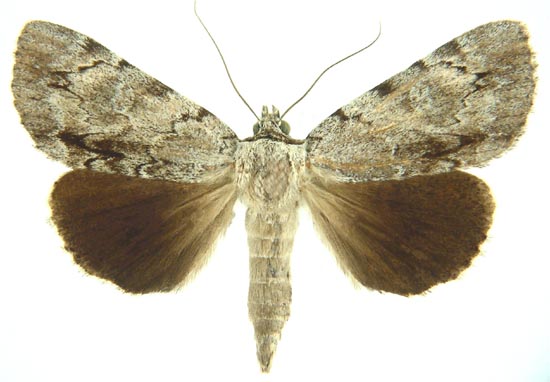Catocala miranda
|
|
Updated as per personal communication from Rick Gillmore, May 7, 2007
|
Catocala miranda
kah-TOCK-uh-lahM
mih-RAN-duh
H. Edwards, 1881

Catocala miranda, Louisiana, courtesy of Vernon A. Brou.
This site has been created by
Bill Oehlke at oehlkew@islandtelecom.com
Comments, suggestions and/or additional information are welcomed by Bill.
| TAXONOMY:
Superfamily: Noctuoidea
Family: Noctuidae
Group: Noctuinina
Subfamily: Catocalinae
Genus: Catocala, Schrank, 1802
| |
MIDI MUSIC
"Moon River"
copyright C. Odenkirk
MIDI CITYON.OFF
<bgsound src="moon.mid" LOOP=FOREVER>
|
DISTRIBUTION:
Catocala miranda, the Miranda
Underwing, (wingspan: 37-45mm) flies from
Pennsylvania and
Massachusetts ??,
to Florida and west to western
North Carolina. The specimen depicted above was taken
in Louisiana.
District of Columbia,
Mississippi,
New York,
Ohio,
Tennessee
Virginia and
West Virginia
The forewing is a plain pale grey with very light and fine black lines,
darker and wider near the costa. The hindwing is black with white fringe at the apex,
turning to grey along the outer margin.
Miranda is smaller than look-alike orba and miranda
also has a dark bar just above the inner margin in the median area, projecting toward the anal angle.
FLIGHT TIMES AND PREFERRED FOOD PLANTS:
Catocala miranda are usually on the wing
from May to early June.
The Catocala miranda caterpillar shows a preference for
hawthorn species.
ECLOSION:
Adults eclose from pupae at soil surface.
SCENTING AND MATING:
Catocala miranda females
emit an airbourne pheromone and males use their antennae to track the
scent plume.
EGGS, CATERPILLARS, COCOONS AND PUPAE:
Eggs are deposited on
tree bark in the fall and hatch the following spring.
Larval Food Plants
Listed below are primary food plant(s) and alternate food plants.
It is hoped that this alphabetical listing followed by the common
name of the foodplant will prove useful. The list is not exhaustive,
although some species seem very host specific.
Experimenting with closely related foodplants is worthwhile.
Crataegus .......
|
Hawthorn (SG)
|
This page is brought to you by Bill Oehlke and the
WLSS. Pages are on space rented from Bizland. If you would like to become a "Patron of the Sphingidae/Catocala Sites",
contact Bill.
Please send sightings/images to Bill. I will do my best to respond to requests for identification help.
Enjoy one of nature's wonderments: Live Saturniidae (Giant Silkmoth) cocoons.

|

To show appreciation for this site, click on the flashing
butterfly to the left, a link
to many worldwide insect sites. |
Return to Canadian Index
Return to Main Index


